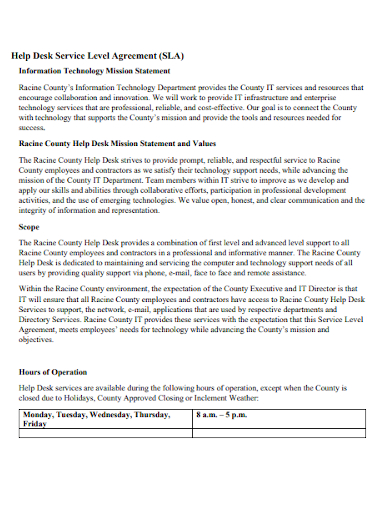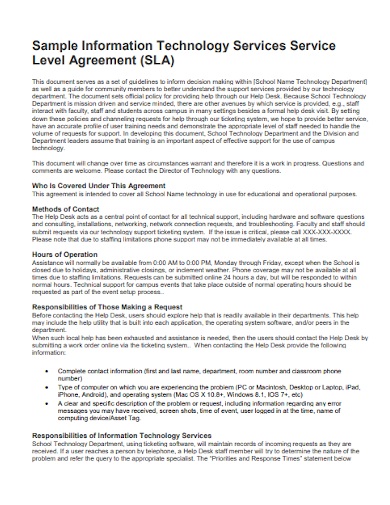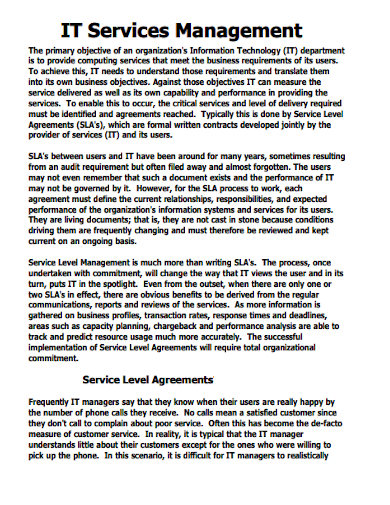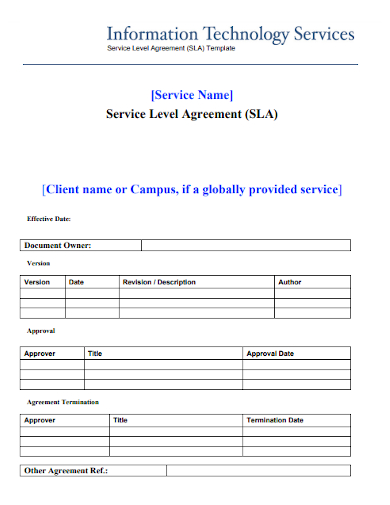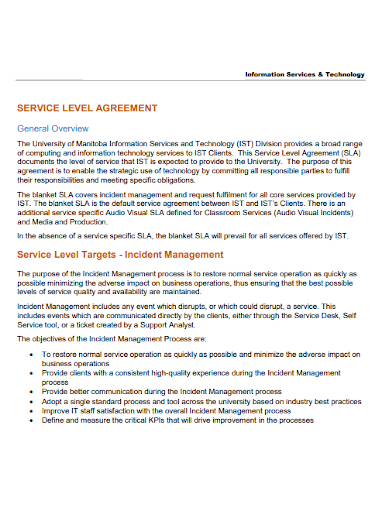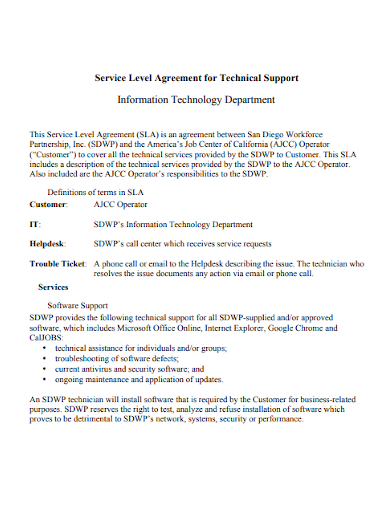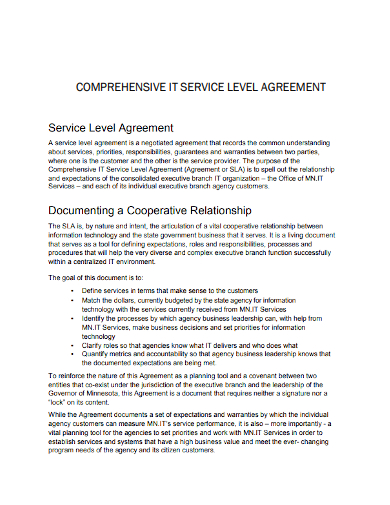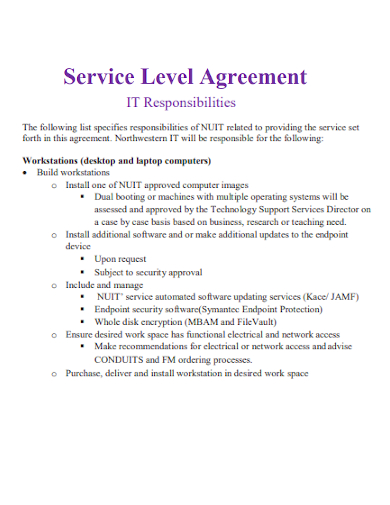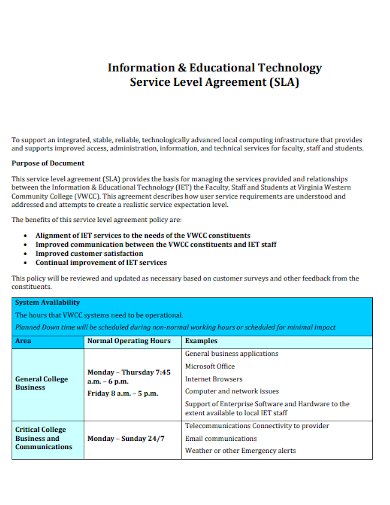SLAs are an essential component of any IT vendor agreement. An SLA is a single document that compiles information on all contracted services and their agreed-upon expected reliability. They explicitly describe measurements, obligations, and expectations so that neither party can claim ignorance if there are problems with the service. It guarantees that both parties are on the same page when it comes to obligations. Any important contract without an accompanying SLA (approved by legal counsel) is vulnerable to misinterpretation, either intentionally or inadvertently. Both parties to the agreement are protected by the SLA. SLAs should, ideally, be aligned with the engagement’s technical or commercial goals. Deal pricing, service quality, and customer experience can all suffer as a result of misalignment.
10+ IT Service Level Agreement Samples
An IT service level agreement (SLA) is a written contract between a company and its IT supplier that establishes expectations for the customer’s level of service. This can include phrases like uptime, customer service response time, maintenance schedules, and more. An IT service legal agreement also spells out what will happen if your IT system fails. These legal documents are essential for building a positive connection with your IT service provider.
1. IT Help Desk Service Level Agreement
2. Sample IT Service Level Agreement
3. IT Service Management Level Agreement
4. Basic IT Service Level Agreement
5. IT Service Division Service Level Agreement
6. IT Service Level Targets Agreement
7. IT Department Service Level Agreement
8. Editable IT Service Level Agreement
9. Comprehensive IT Service Level Agreement
10. IT Responsibilities Service Level Agreement
11. IT Educational Service Level Agreement
Importance of IT Service Level Agreement
SLAs are necessary for service providers to manage customer expectations and to establish the severity levels and conditions in which they are not liable for outages or performance issues. Customers can also benefit from SLAs because the contract outlines the service’s performance characteristics, which can be compared to those of competing vendors, as well as the methods for resolving service concerns.
The Service Level Agreement (SLA) is one of two basic contracts that service providers have with their clients. Many service providers create a master service agreement to spell out the general terms and conditions under which they will engage with their clients.
The SLA is frequently referenced in the master service agreement of the service provider. The SLA adds further specificity to the services offered and the criteria that will be used to compare their performance between the two service contracts. The services that are included in the service offering are defined by service obligations.
SLAs arose as a framework to control such interactions when IT outsourcing became popular in the late 1980s. Service-level agreements specify the expectations for a service provider’s performance, as well as penalties and, in certain cases, bonuses for surpassing those goals. Outsourcing SLAs were usually developed to regulate a unique project because outsourcing initiatives were frequently customized for a specific customer.
SLAs change to handle new ways as managed services and cloud computing services become more common. The modern contracting approaches are characterized by shared services rather than tailored resources, so service-level commitments are typically utilized to construct broad agreements that are meant to cover all of a service provider’s customers.
FAQs
What is an indemnification clause?
An indemnity clause is a crucial condition in which the service provider undertakes to hold the customer company harmless in the event of a breach of its warranties. Indemnification refers to the provider’s obligation to reimburse the customer for any third-party litigation costs incurred as a result of the provider’s breach of the warranties. If you employ the service provider’s standard SLA, this clause is likely to be missing; ask your in-house counsel to craft a basic provision to include it, but the service provider may wish to discuss this further.
Who needs a service level agreement?
SLAs are said to have started with network service providers, but they’re now utilized in a variety of IT-related fields. IT service providers and managed service providers, as well as cloud computing and internet service providers, are some of the industries that use SLAs.
If you want to see more samples and formats, check out some IT service level agreement samples and templates provided in the article for your reference.
Related Posts
FREE 10+ Mentoring Agreement Samples In MS Word | Apple Pages | PDF
FREE 10+ Partner Agreement Samples In MS Word | Google Docs | Apple Pages | PDF
FREE 10+ Individual Agreement Samples In MS Word | Google Docs | Apple Pages | PDF
FREE 10+ Strategic Agreement Samples In MS Word | Google Docs | Apple Pages | PDF
FREE 10+ Equity Agreement Samples In MS Word | Google Docs | Apple Pages | PDF
FREE 10+ Producer Agreement Samples in MS Word | Apple Pages | PDF
FREE 10+ Grant Agreement Samples In MS Word | Apple Pages | PDF
FREE 8+ Meeting Agreement Samples in MS Word | Google Docs | Apple Pages | PDF
FREE 10+ Community Agreement Samples In MS Word | Google Docs | PDF
FREE 8+ Real Estate Option Agreement Samples in MS Word | PDF
FREE 10+ Call Option Agreement Samples In MS Word | PDF
FREE 10+ Advertising Agreement Samples In MS Word | Google Docs | Apple Pages | PDF
FREE 10+ Car Agreement Samples In MS Word | Google Docs | Apple Pages | PDF
FREE 10+ Horse Agreement Samples In MS Word | Apple Pages | PDF
FREE 10+ Option Agreement Samples In MS Word | Google Docs | Apple Pages | PDF

